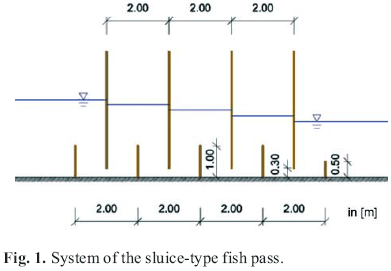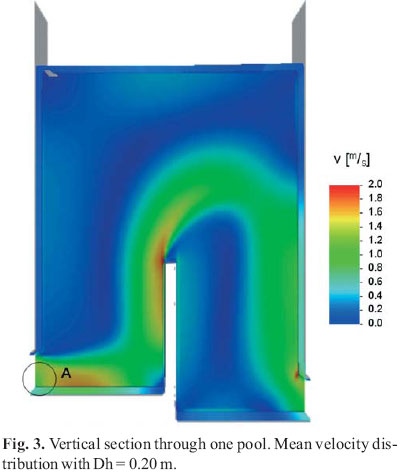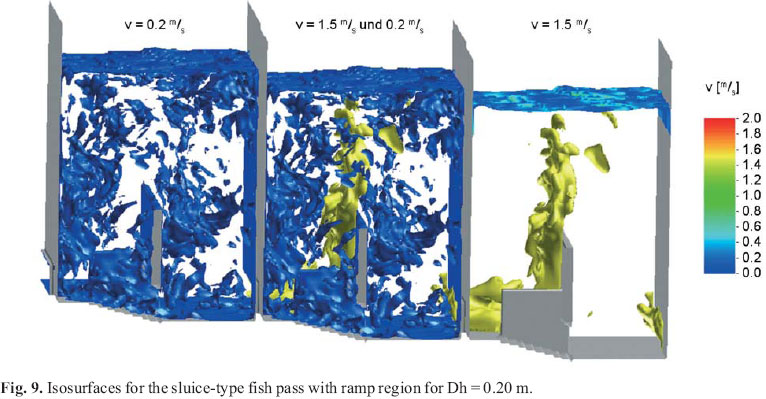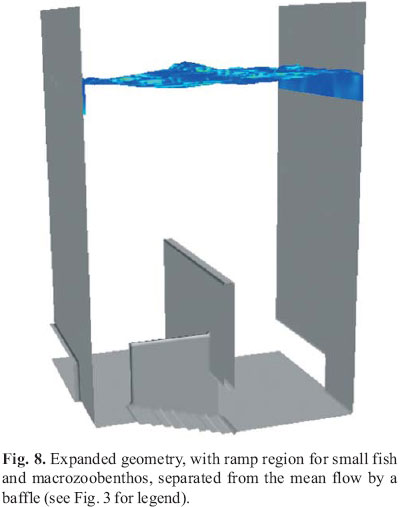Abstracts
One-dimensional design of fish passes often leads to an unsatisfying solution. The problems are due to insufficient, if not completely missing, collaboration between biologists and civil engineers. In the present paper, a new type of fish pass is presented. A labyrinth flux develops in a system of sequential sluices and baffles in between, which uncouple the supercritical flow of the single sluices. A series of biological, hydraulic and numerical experiments was carried out in order to investigate the optimum configuration in terms of geometric issues, regarding the biological needs and performances of organisms to be transported. Following this optimization, fish can control the prevailing flow conditions quite well. Because the air entrainment into the water is avoided, fish perception is not affected. A geometric extension regarding the needs of small fish, bottom fish, and macrozoobenthos decreases the selectivity and predation pressure on them.
Air entrainment; Labyrinth flow; Computational fluid dynamics; Macrozoobenthos; Hydro acoustic noise
O projeto uni-dimensional de passagem para peixes leva, com freqüência, a uma solução pouco satisfatória. Os problemas são conseqüências de uma falta ou insuficiência de colaboração entre biólogos e engenheiros civis. Neste artigo é apresentado um novo tipo de passagem para peixes. Este é constituído por um sistema de vertedores seqüenciais com paredes intermediárias entre eles. Estas paredes têm o objetivo de desacoplar o fluxo supercrítico entre os vertedores desenvolvendo uma corrente do tipo labirinto. Um conjunto de experimentos biológicos, hídraulicos e numéricos foi realizado para achar a melhor configuração a respeito da geometria, levando-se em consideração os aspectos biológicos dos indivíduos a serem transpostos. Observou-se que após a colocação desses dispositivos os indivíduos testados ultrapassaram o sistema com relativa facilidade. O mecanismo evita a incorporação do ar na água. Devido a isso a percepção do peixe nao é afetada. Com a colocação de um sistema de passagem de fundo, a seletividade do sistema e a pressão de predação é diminuída, pois se considera que os peixes menores, os peixes do fundo e o macrozoobenthos terão mais facilidade de passar por este mecanismo do que pelas passagens de peixes tradicionais.
SCIENTIFIC NOTE
Proposal of a sluicetype fish pass
Matthias A. HaselbauerI and Carlos Barreira MartinezII
IFachgebiet Hydromechanik, Technische Universität München, Arcisstr. 21, 81549 München, Germany. m.haselbauer@bv.tum.de
IIDepartamento de Engenharia Hidráulica e Recursos Hídricos, Av. Antônio Carlos 6627, Campus da UFMG Pampulha, 31270901, Belo Horizonte, MG, Brazil. martinez@cce.ufmg.br
ABSTRACT
Onedimensional design of fish passes often leads to an unsatisfying solution. The problems are due to insufficient, if not completely missing, collaboration between biologists and civil engineers. In the present paper, a new type of fish pass is presented. A labyrinth flux develops in a system of sequential sluices and baffles in between, which uncouple the supercritical flow of the single sluices. A series of biological, hydraulic and numerical experiments was carried out in order to investigate the optimum configuration in terms of geometric issues, regarding the biological needs and performances of organisms to be transported. Following this optimization, fish can control the prevailing flow conditions quite well. Because the air entrainment into the water is avoided, fish perception is not affected. A geometric extension regarding the needs of small fish, bottom fish, and macrozoobenthos decreases the selectivity and predation pressure on them.
Key words: Air entrainment, Labyrinth flow, Computational fluid dynamics, Macrozoobenthos, Hydro acoustic noise.
RESUMO
O projeto unidimensional de passagem para peixes leva, com freqüência, a uma solução pouco satisfatória. Os problemas são conseqüências de uma falta ou insuficiência de colaboração entre biólogos e engenheiros civis. Neste artigo é apresentado um novo tipo de passagem para peixes. Este é constituído por um sistema de vertedores seqüenciais com paredes intermediárias entre eles. Estas paredes têm o objetivo de desacoplar o fluxo supercrítico entre os vertedores desenvolvendo uma corrente do tipo labirinto. Um conjunto de experimentos biológicos, hídraulicos e numéricos foi realizado para achar a melhor configuração a respeito da geometria, levandose em consideração os aspectos biológicos dos indivíduos a serem transpostos. Observouse que após a colocação desses dispositivos os indivíduos testados ultrapassaram o sistema com relativa facilidade. O mecanismo evita a incorporação do ar na água. Devido a isso a percepção do peixe nao é afetada. Com a colocação de um sistema de passagem de fundo, a seletividade do sistema e a pressão de predação é diminuída, pois se considera que os peixes menores, os peixes do fundo e o macrozoobenthos terão mais facilidade de passar por este mecanismo do que pelas passagens de peixes tradicionais.
In Europe, the use of surface water has constantly increased during the past 150 years. To maintain navigability, for hydropower purposes, and for protection against flood waters, a large number of constructions were built which interfere with the natural flow. Fish and other small animals which inhabit the rivers suffer from these alterations. A massive decrease in the number of fish to the point of extinction of some species has been observed. The example of Brazil indicates that this decrease must be seen as a global problem. With the simultaneous decrease in fish, bird and mammal populations, the enormous human impact on the food chain has become obvious.
In an attempt to keep rivers passable for organisms, a huge number of fish passes were built during the last centuries, but their efficiency in both biological and technical aspects is often poor. The flow situations in the constructions which were often designed under onedimensional and empirical assumptions resulted in an immense selectivity. Moreover, the intolerable noise emission prohibits the installation of such constructions near urban areas. The necessarily small slopes of fish passes require great lengths, which results in very high costs along with high maintenance needs. In contrast to the traditional onedimensional design of fish passes, more appropriate tools are available today. With computational fluid dynamics (CFD tools), not only the mean velocity field can be investigated, but also transient effects of the flow, which have a considerable influence on the acceptance of such constructions. To achieve optimum results, a coupling of hydraulic and biological aspects is essential in the design process. Examinations of the flow conditions in most of the traditional fish passes such as pooltype and weirtype and vertical slottype passes, disclose air entrainment. The air is broken up by turbulent shear forces into small stable air bubbles, which due to buoyancy rise towards the surface and escape into atmosphere. The bubble fragmentation leads to hydro acoustic noise (Deane, 2002), discernible by fish (Kapoor, 2004), and to major air noise in the vicinity of such constructions.
In the present paper a new type of fish pass is presented. To investigate the optimum configuration for the new system, a combined biological, physical and numerical test program was set up. In the summer of 2005, a fish pass was installed on a scale of 1:5 in an acrylic glass channel with a width of 30 cm. The model consisted of three inner basins which were separated by acrylic glass sluices. The minimum water level in the mechanism was set by a weir at the end of the channel. The weir had a minimum height of 30 cm. During the experiments the sluices were covered with a blue plastic film to improve the visual perceptibility of the fish.
At the Centre of Hydraulic Research (CPH), Universidade Federal de Minas Gerais (UFMG), Belo Horizonte, Brazil, the researchers worked combining biological and technical experiments in the field of fish pass improvement. Because of this special configuration, it was possible to test the new systems with two different species of fish that were caught in Três Marias Reservoir (18°12'48" S, 45°15' 58" W) in the São Francisco River. The performance was tested with piau (Leporinus reinhardti) and lambari (Astyanax bimaculatus). The species are representative for different living spaces with regard to water depth and behavior. While the lambari is a shoal fish which adapts its own behavior to that of conspecifics, the piau reacts more autonomously with respect to its environment.
For the experiments, five fish of the same species were taken each time and released into the fish pass at the downstream end. The positions of the respective fish were documented in 10min intervals. The experiment was repeated three times for the two species at two different currents. The results were evaluated using statistical methods.
The test channel with integrated sluices was built twice, one in Brazil as already mentioned, and the other at the Technische Universität München in Germany. To verify the results of numerical simulations, various flows were investigated in the channels. Discharges were measured with a current meter in Brazil and with a magnetoinductive discharge measurement device in Germany. For each discharge under a specific end weir height, the water levels in the different pools were measured with their mean values and variances. The velocities within one of the pools were additionally monitored by a laser doppler anemometer (LDA) measurement device and compared with the numerical results.
As a first step, the laboratory experiments described above were simulated and the results were compared. The simulations were performed with the code Flow3D® of FlowScience®.
To avoid air entrainment (Boes, 2004), the idea was to dissipate the energy by means of a series of submerged sluices. Fig. 1 shows the main principle. The first numerical simulations showed a labyrinth flow as shown in Fig. 2 and Fig. 3. The maximum velocity was about 2 m/s H" (Dh/2g)0.5; the entire potential energy was transformed into kinetic energy which was later dissipated in the pool. Along the bottom and the intersection wall attached, wall jets were constructed. Within the pool, only small areas of high velocities were formed where the jets were detached from the walls. Of more importance for fish were large recuperation spots in the recirculation areas.
To guarantee the continuity of the bottom, the original 2D geometry was extended by 50 cm. A ramp region with a width of 30 cm was added which was separated by a baffle from the main flow, thereby creating a continuous bottom . Due to the fact that the velocities in this region were less than 0.20 m/s, small fish and macrozoobenthos can pass through the mechanism. In the section slides (Fig. 3, area A), it can be seen that at the bottom side of the vertically guided jet the velocity is about 1 m/s, which increases the chances of small fish passage.
In a very long fish pass, the basins can be regarded as periodic. For this configuration only one basin had to be simulated with a periodic inflow and outflow condition. For optimization purposes in the geometry (Fig. 4), the different parameters, a) water level in the pool, b) intermediate wall height, c) level difference between the pools, d) opening under the sluice, e) the dimension of the pool and f) position of the wall, were varied. Steady and unsteady transient schemes were used for the simulations. The turbulence models applied were Reynolds averaged NavierStokes (RANS) and large eddy simulation (LES) (Fig. 5).
As described above, the tests were made in the acrylic channel with a width of 30 cm. Fish, in this case lambari (Astyanax bimaculatus), were set free at the downstream side of the vertical sluices. The fish had a total length of 9 to 12 cm. To protect the fish against leaving the test domain, a net was set between the exit of the fish pass and the end weir. The discharge in the channel was 340 l/min, with a water level of 45 cm upstream and 35 cm downstream of the fish pass. The slope of the mechanism was about 8%. Fig. 6 shows the distribution of fish over time. After releasing the fish into the channel, about 20% of the fish passed within 10 min through the entire fish pass. The greater part of the fish, about 65%, passed the mechanism more slowly, and passed one pool after the other. After almost an hour, 85% of the fish passed the mechanism once. It was recognized that some fish, after passing the sluices once, reentered the mechanism and swam downstream. While observing these fish, it appeared that the lambaris were able to control the prevailing velocity regimes quite well. A typical passage of fish can be seen in Fig. 7, where the passage was photographed in a sequence of images.
The discharge measurements were carried out in a scaled model. To compare the different results, the scaling law between the different scales are of importance. In CFDsimulations of free surface flow, it was proven that the velocities in the model scale followed the Froude Law:
where v is the velocity and l is a characteristic length. The velocities can therefore be transferred quite easily between different scales.
As applied to every pooltype fish pass, the maximum velocity in the pool can be estimated by:
where Dh is the level difference between two basins. The water head difference is converted directly into velocity head. This law applies to every pooltype fish pass, including scaled models.
The laboratory experiments with the horizontal channel demonstrated that there is no "white" water in the fish pass. Because of the submerged sluices, no air was entrained into the flow regime. The water remained clear. If the water level in the pools was too low, down going vortices from the surface developed, which led to the suction of air from the surface into the flow domain. Single bubbles passed the sluice and usually left the fluid domain at the other side of the sluice. Sometimes bubbles were trapped in the recirculation zones. These bubbles are acoustically inactive, because they were not fragmented, but maintained their diameter until escaping from the water. The risk of entrainment of these bubbles increased with increasing discharge and decreasing water level.
A very important criterion for the performance of the fish passes is the velocity distribution. As in traditional facilities, the maximum level difference between two pools should not be higher than 20 cm, which corresponds to a maximum velocity of about 2.0 m/s (ATVDVWK, 2004). Because of the vertical direction change of the jet, the length of the separate basins may be reduced, which enables a steeper slope of the fish pass. For geometrical optimization of the mechanism, numerical parameter studies were conducted, which allowed the prediction of the best geometrical configuration.
In discussions with biologists, it is often claimed that the bottom is not continuous. Because of this, the organisms that live near the bottom would not pass through a fish pass, because they would not climb up the middle wall which separates the flow under the single sluices.
In order to address these concerns, the original twodimensional geometry was expanded by a ramp region which is separated from the main flow by a baffle, as can be seen in Fig. 8 and Fig. 9. Within a pool, there were no potential head differences. Because of this, there was almost no flow in the ramp region. The opening in the wall had a width and height of 30 cm, corresponding to the construction recommendations of the German Association for Water, Wastewater and Waste (DWA) for pooltype fish passes. (DVWK, 1996) In this region, especially small fish, bottom dwelling fish, and macrozoobenthos (ATVDVWK, 2004) had the possibility to move up. Because of the limited space available, hunting by predators (Almeida, 2006) will become more difficult. Therefore, movements of small organisms within the fish pass will be easier.
The biological experiments could give a good idea of the feasibility of the new fish pass, but there is the inevitable argument that scaled experiments with fish are always tricky. Although the physical capacities of fish can be scaled satisfactorily, the attitudes of juvenile and adult fish differ greatly. However, the fish passed quite well, as shown.
The proposed mechanism represents an application of jet hydraulics. In contrast to the traditional fish passage systems, air entrainment into the water was avoided, which is responsible for noise in the air and in the water (Deane, 2002). The proposed fish pass, therefore, produced notably less noise because of its design. Moreover, upwards movements of fish were not disturbed by the transported air bubbles, but it is still necessary determine whether or not fish are affected by these bubbles. If they are not hindered in passing a respective area, they are still affected in their sensory perception and orientation by the bubbles. Because of this, it may be assumed that without bubbles they are able to detect predators earlier when passing the fish pass. Therefore, the chances to overcome the mechanism completely are increased.
The given inclination for the fish in the experiment was about 8 to 10%. It can be assumed that this inclination can still be increased considerably. Biologists measure the recommended velocities in fish length per second (Sfakiotakis, 1999; DVWK, 1996). Because of this linear scaling law for fish, the swimming capacities of fish increase by a factor of two by doubling the geometric parameters. At the same time, the prevailing velocities increase by the square root of two only, following the scaling law of Froude. Fish should therefore manage to pass increased inclinations more easily at larger scales than at small ones. At the CPH in Brazil, in the next months, a larger test channel with a scale of 1:2 will be completed. More biological tests with more species will be performed. If the tests give the prognosticated results, the new system will be fieldtested.
Acknowledgements
The results presented were obtained by combining the work of two internationally reputed research institutes. The Fachgebiet Hydromechanik of the Technische Universität München, with Prof. Dr.Ing. M. Manhart and Prof. Dr.Ing. F. Valentin, contributes a comprehensive knowledge in the field of hydraulics and turbulence, while the Centre of Hydraulic Research at the UFMG in Belo Horizonte, headed by Prof. Carlos Barreira Martinez, offers an optimum combination of biological and engineering knowledge on the topic of fish passes. The authors wish to thank all colleagues who inspired the project with their knowledge, concerns and suggestions.
Literature Cited
Received January 2007
Accepted May 2007
- Almeida, D. A. A. 2006. Avaliação da eficiência do sistema para transposição de peixes da Usina Hidroelétrica Luís Eduardo Magalhães TO. Unpublished Master Thesis, Universidade Federal do Tocantins, Palmas. 82p.
- ATV–DVWK. 2004. Fischschutz– und Fischabstiegsanlagen – Bemessung, Gestaltung, Funktionskontrolle. Deutsche Vereinigung für Wasserwirtschaft, Abwasser und Abfall e.V., Hennef. 215p.
- Boes, R. & G. Ötzbrugger. 2004. Bemessung eines getreppten Gabionenwehres zur Verringerung von Luftschallemissionen bei Überströmung. Wasserwirtschaft : Hydrologie, Wasserbau, Boden, Ökologie, 94(6): 914.
- Deane, G. B. & M. D. Stokes. 2002. Scale dependence of bubble creation mechanisms in breaking waves. Nature, 418, 839844.
- DVWK. 1996. Fischaufstiegsanlagen: Bemessung, Gestaltung, Funktionskontrolle. Wirtschafts– und Verl. Ges. Gas und Wasser, Bonn . 110p.
- Kapoor, B. G. 2004. Ichthyology Handbook. Springer, 1058p.
- Peake, S. 2004. An evaluation of the use of critical swimming speed for determination of culvert water velocity criteria for smallmouth bass. Transactions of the American Fisheries Society, 133: 14721479.
- Sfakiotakis, M., D. M. Lane & J. B. C. Davies.1999. Review of Fish Swimming Modes for Aquatic Locomotion. IEEE Journal of Oceanic Engeneering, 24(2): 237252.
- Valentin, F. 1968. Einfluss des Unterwasserstandes auf die Strömungsverhältnisse beim Ausfluss unter einer Schütze. Institut für Hydraulik und Gewässerkunde, Mitteilungen, Heft 1, TH München. 96p.
Publication Dates
-
Publication in this collection
24 July 2007 -
Date of issue
2007
History
-
Accepted
May 2007 -
Received
Jan 2007












